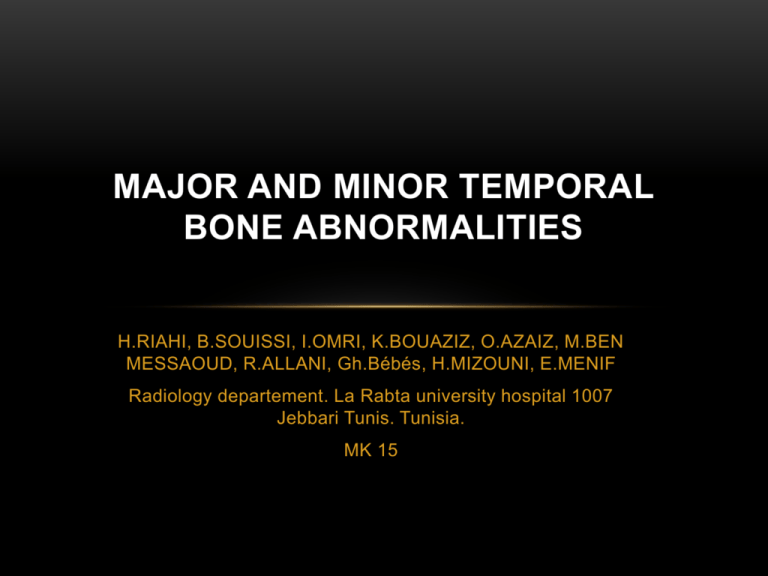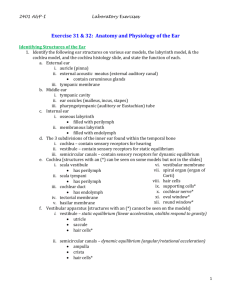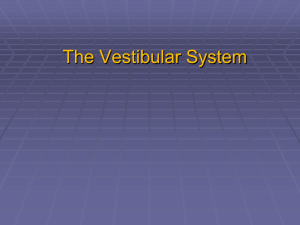Présentation PowerPoint
advertisement

MAJOR AND MINOR TEMPORAL BONE ABNORMALITIES H.RIAHI, B.SOUISSI, I.OMRI, K.BOUAZIZ, O.AZAIZ, M.BEN MESSAOUD, R.ALLANI, Gh.Bébés, H.MIZOUNI, E.MENIF Radiology departement. La Rabta university hospital 1007 Jebbari Tunis. Tunisia. MK 15 INTRODUCTION • In contrast to anatomical variants, congenital malformations (CM) – synonyms are abnormalities or dysplasias – are not only characterized by a deviation from normal anatomical development, but also from regular function. • They can result from a developmental arrest, irregular embryogenesis or from both due to spontaneous genetic mutations – this is the case in the majority of CM of the ear –, genetic transmission, and exogenic factors— in about 10% of cases. • CM of the ear may be found in syndromes—the most known of them are the Franceschetti (Treacher-Collins), Goldenhar and Klippel-Feil syndrome. MATERIALS AND PATIENTS • Retrospective study during 48 months from July 2008 to June 2011 . • 50 patients were explored with MDCT including o 26 women o 24 men • All of them consulted for sensorineural hearing loss. EXPLORATION METHOD • CT examinations of the temporal bone are performed at our institution by using a GE 64 multislices CT without injection of iodinated contrast: 50 patients so 100 ears • Acquisition sub-millimeter volume • Axial reconstruction: lateral semicircular canal plan • Perpendicular coronal reconstructions • Oblique reconstructions: Reconstructed double-oblique coronal image shows normal anatomy of the long axis of the incudal body , double-oblique orientation of the axial reconstruction plane enables the optimal display of both the crura and the stapedial footplate at the oval window, Oblique coronal planes located along the long axes of malleus and incus • The following structures were evaluated in 100 temporal bones: The external auditory canal: stenosis or atresia of the cartilaginous part of the auditory canal, stenosis or atresia of the bony part, The extent of the middle ear cavity, form of tegmen. Diminution, dysplasia, rotation, fusion, ectopia, tympanic wall adherence Ossicular chain dysplasia, fusion, absence Labyrinthine windows open or closed; fistula. Cochlear turns, vestibule, semicircular canals, aqueducts. The internal auditory canal Facial nerve canal: aberration, dehiscence, hypoplasia, thickening, splitting. RESULTS • External and medial ear deformity: structure nombre External auditory canal 9 (in 9 patients) Tympanic cavity 3 (3 patients) Oval/ round windows 24 (15 patients) malleus 24 (19 patients) incus 31 (23 patients) stapes 34 (24patients) • Inner ear deformity structure nombre Michel 4(2patients) Cochlear dysplasia 8 (8 patients) Vetibule dysplasia 22 (12patients) Semicircular canal 60 (41 patients) Vestibular aqueduct 10 (6 patients) Internal auditory canal 17 (10patients) EMBRYOLOGY • In the 3rd week of gestation: formation of the otic placode, an ectodermal thickening in the neighborhood of the myelencephalon. Invagination of the otic placode leads to an otic pit and to fusion of their external lips to the otic vesicle. • In the 8th week, the otic capsule is formed, providing the stapes footplate and the ligament of the oval window. • By the 12th week, the labyrinth is well differentiated. • The facial nerve grows to reach its destinations between the 4th and 5th week. • The middle and external ear develops from the mesodermal first and second branchial arch and the endodermal first pharyngeal pouch between the fourth and 30th weeks. • Developmental anomalies of the first pharyngeal pouch lead to disturbances of the eustachian tube and of the tympanic and mastoid pneumatization. • Failure of differentiation of the first branchial arch leads to malformations of the incudomalleal joint, tensor tympani muscle, and mandible. • Failure of differentiation of the second branchial arch affects the facial nerve canal, the stapedius muscle, the lower part of the ossicular chain, and the styloid process. • Disorders of the first and second branchial arches also result in dysplasia of the auricular cartilage (leading to microtia in the seventh to eighth week, the earlier the more severe, or to anotia in the seventh week). • The external auditory canal arises from deepening of the first branchial groove in the 9th week. Opening of the bony part of the external auditory canal starts only in the 30th week, after complete differentiation of the inner, middle, and outer ear. • Failure of the epithelial cells of the first branchial groove to split causes stenosis or atresia of the external auditory canal, which might be isolated in an otherwise normal temporal bone. • Anomalies of the internal carotid artery are thought to be caused by maldevelopment of the third branchial arch during the 4th week DISCUSSION INNER EAR DEFORMITY • Most inner ear malformations arise when formation of the membranous labyrinth is interrupted during the first trimester of pregnancy. • Only approximately 20% of patients who present with congenital SNHL have imaging manifestations. • Malformations of the inner ear may be associated with various other embryological abnormalities: cervical fistula, renal abnormalities in the brachio-oto-renal syndrom. Schematic representation of different stages of developmental arrest in the inner ear development. The letters a and b represent sections through the internal auditory canal and round window, respectively. A: cochlear aplasia/deformity Normal cochlea Michel deformity: complete labyrinthine aplasia. Vestibule and semicircular canal dysplasia Cochlear aplasia Enlarged vestibular aqueduct. Common cavity. Incomplete partition Cochlear hypoplasia MICHEL DEFORMITY • Complete absence of all cochlear and vestibular elements. • Rarely unilateral. • Associated lesions: Aberrant facial nerve Absent stapes Abnormality of the skull base Aberrant internal carotid stapedial artery COCHLEAR APLASIA • This is seen as dense otic bone on the anterior part of the IAC. • Because of the absence of the cochlea, the course of the labyrinthine segment of the facial canal is more anterior at the usual location of the cochlea. • It is important to differentiate this malformation from cochlear ossification in which the basal turn of the cochlea produces the characteristic bulging in the middle ear(the promontory). COMMON CAVITY. • cochlea and vestibule form a common cavity, which represents both of these structures without any differentiation. • Usually, the internal auditory canal enters the common cavity at its center. INCOMPLETE PARTITION • Cystic dilated vestibule accompanied the cystic, empty cochlea. • the dimensions of the cochlea and vestibule are normal but the internal architecture is missing. • There is no modiolus in the cochlea, giving it the shape of an empty cystic structure. • Usually, the cribriform area between the cochlea and the IAC is also defective. COCHLEAR HYPOPLASIA • Cochlear and vestibular structures are separate from each other. • In hypoplasia the cochlea is smaller than normal. • Only the basal turn is developed, the other turns form one commun cavity. • The accompanying vestibular malformation is usually absence or hypoplasia. VESTIBULE AND SEMICIRCULAR CANAL DYSPLASIA • SCC malformations also frequently occur in association with other inner ear anomalies. • The SCCs begin as disk-shaped evaginations arising from the vestibular appendage in the 6th gestational week. • The superior SCC is the first to form, followed by the posterior and then the lateral SCC. Therefore, superior and posterior SCC anomalies are almost invariably associated with anomalies of the lateral SCC, whereas abnormalities of the lateral SCC can occur in isolation. • On axial CT images, subtle SCC abnormalities may be indicated by a small or enlarged lateral SCC bony island. Normally, the transverse diameter of this bony island measures between 2.6 and 4.8 mm LARGE VESTIBULE • There appears to be a reciprocal relationship between the size of semi circulars canals particularly the lateral canal and the size of the vestibule. • An enlarged vestibule is associated with underdeveloped lateral semi-circular canal ENLARGED VESTIBULAR AQUEDUCT • Vestibular aqueduct enlargement (also referred to as enlarged vestibular aqueduct syndrome) is the single most common inner ear anomaly seen in individuals with SNHL. • It is frequently seen in association with other inner ear anomalies( vestibular enlargement, and SCC dysplasias) • On CT, vestibular aqueduct enlargement is diagnosed when the aqueduct is 1.5 mm in width (roughly the diameter of the simultaneously visualized posterior SCC) at the midpoint between the common crus and its external aperture. • MR imaging additionally demonstrates enlargement of the endolymphatic duct and sac. SMALL INTERNAL AUDITORY CANAL • This deformity is characterized by a decrease in the diameter of the IAC • Presumably, this hypoplastic changes are secondary to hypooplasia or aplasia of the cochlear nerve EXTERNAL AND MIDDLE EAR DEFORMITY • Many classifications Moderate malformation Severe malformation • Elementary lesions: External acoustic canal Middle ear ossicular chain EXTERNAL AUDITORY CANAL • Failures of the canalisation result in EAC malformations including membranous and/or bony atresia. • The classification of malformations of the EAC according to Weerda EAC stenosis type A: a marked narrowing of the EAC with an intact skin layer. EAC stenosis type B: a partial development of the EAC with an atresia plate at the medial part. Type C: complete bony EAC atresia. MIDDLE EAR • Middle ear malformations can affect the normal development of the tympanic cavity as well as ossicles and form a continuum with varying degrees of involvement. • This is linked with a change in configuration or size of middle ear spaces: Mastoid pneumatization may be reduced or absent. Tympanic cavity: may be o hypoplasia: the cavity is shorter and or smaller than normal; o split-like deformed: then often opacified and filled with non-resorbed embryonic or fibrosing tissue o aplasia:absence o extracavitation: an additional cavity on a wrong place • There may be abnormalities of the oval window and, rarely, of the round window. OSSICULAR CHAIN • Malleus: fused malleus and incus fixation of malleus and/or incus on the tympanic wall aplasia of the head of the malleus • Incus: No or hypoplasic incus long process Incus fused to medial attic wall No connexion with malleus incus long process fused to promontrium Fused incus and stapes • Stapes: Stapes without anterior crus or stapes suprastructure Stapes with monopolar crus Stapes footplate fixation No stapes footplate CONCLUSION • Well-established temporal bone abnormalities such as cochlear and vestibular abnormalities and a grossly enlarged vestibular aqueduct are significantly found in patients with sensorineural hearing loss. • CT and MRI allow labelling from isolated malformations or from simple morphological considerations to guide to an abnormal type geyser, a syndrome branchio-oto-renal or load before any result would then specify the genetic disorder in question.




